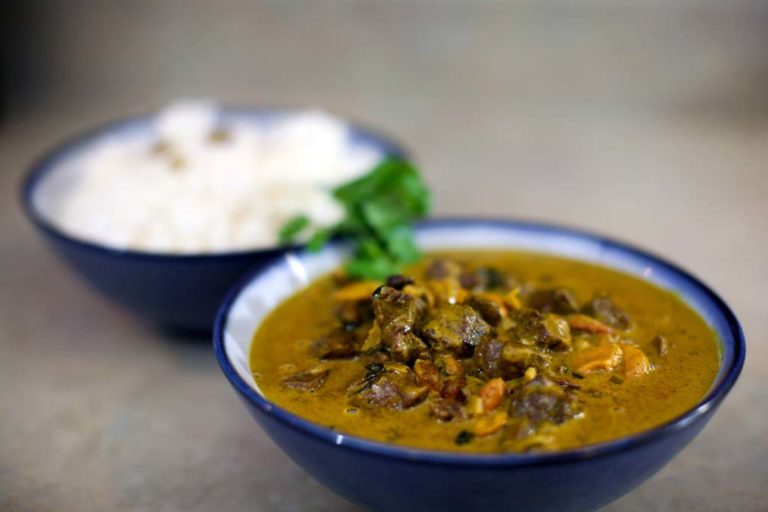
Chef's notes:
Getting past chicken curry and finding new curried meats was an important step in my life. Otherwise, how would I have ever discovered the wonders of curried yak meat? Don’t get me wrong, I still like chicken, it’s just that I’d rather be eating something else if I could. I used to be the guy who always ordered the chicken shahi korma curry dish. Once I tried the lamb shahi korma, I began to realize that I had truly been missing out. Once you have the very obvious realization that somewhere out there is something better than what you have right in front of you, it’s hard not to go a little nuts. I had that very obvious realization about my life several years ago. I was oblivious to my situation, and once I opened that can of worms, accepted it as reality, and embraced it as a noble truth, there wasn’t much I could do but follow and see where it took me. Lamb curry is but one stop on the ride. So try it out and see how it goes.
Ingredients
- 2 pounds cubed lamb meat
- Sea salt (season the meat)
- Black pepper (season the meat)
- 1 Tbsp vegetable oil
- 1/2 large minced onion
- 6 cloves minced garlic
- 2 Tbsp fresh minced ginger
- 2 Tbsp garam masala
- 1 cup hot water
- 1 cup plain yogurt
- 1 1/2 cup heavy cream
- 1/4 cup chopped cilantro
- 2 Tbsp lemon juice
- 1/2 cup roasted cashew
- 1/2 cup chopped golden raisin
- 2 Tbsp honey (optional)
Lamb Curry Recipe: Lamb Curried with Garam Masala, Onions, Ginger, Yogurt, Cream, Cashew and Golden Raisin
- Gather the ingredients for lamb curry. Leg of lamb is a good choice for curry. It is a tender meat, but is often the most readily available cut of lamb. The cut of leg that I use is a top round, the best part of the hind leg. The front leg is often referred to as the shoulder. The other ingredients are listed at the right.
- Prep the lamb curry ingredients and stage them for cooking. I like to prep my ingredients into stage bowls, so that I can quickly toss the ingredients in when it comes to that stage. The first step is to cut the lamb into cubes, and season with salt and pepper. Next, mince the onion, garlic, and ginger. Lastly, combine the cream and yogurt in a bowl. Set aside the hot water, though.
- Fry the lamb over high heat with the oil or ghee. Heat up 1 tablespoon of vegetable oil, butter, or ghee (if you have it), in a frying pan on high heat. I use a non-stick frying pan with high sides. Once that is spitting, add the lamb and stir fry it quickly. You’ll want to get the lamb dark brown, not just grey.
- Add the onion, garlic, and ginger to the lamb. Lower the heat to medium-high and add the onion, garlic, and ginger. Stir the mixture for a few minutes until the onion is soft. If things look like they are about to burn, lower the heat to medium.
- After a few minutes, add the garam masala to the pan. If you haven’t lowered the heat to medium yet, do so now. Add the garam masala and stir into the lamb. The high heat should help to release some of the essential oils in the curry mixture.
- Stir in the hot water, yogurt, and cream to the lamb. Add the hot water first, and stir it in to cool the pan a little, before adding the yogurt and cream mixture. Mix the whole thing up really well. Cover and let simmer for 10 minutes over medium heat. I used Greek yogurt, but any plain yogurt would do.
- Add the chopped cilantro to the lamb. Remove the cover and stir in the chopped cilantro. Return the lid and simmer for another 10 minutes on medium heat. Taste it to see how the flavors are coming, or to the tenderness of the lamb.
- Toss in the cashews, golden raisins, and lemon juice with the lamb. The lamb should be nice and tender after 20 minutes or so of braising in the pot on the stove. Give it a taste and add salt, if necessary. If you want a little sweeter flavor to it, add some honey. Don’t forget that the golden raisins will add some sweetness. Toss in the raisins, cashews, and lemon juice, and mix well. Serve immediately with rice.
Tips & Tricks
- Try to use fresh lamb within a couple days of purchase.
- Making your own garam masala may make your curry better than mine. There are many recipes for garam masala, which translates to “spicy mixture.” Spicy as in “many spices,” not “hot spicy.”
- Make sure you braise the meat until the lamb is tender and the sauce is a good consistency. If the sauce thickens before the meat is tender, add more water.
- I advise not to add the cashew until the end because they will get mushy if you add them too early. However, you can add the raisins earlier.
- Adding honey is a better way to sweeten the curry because it will mesh better with the sweet flavor of the raisins.
- If your curry has turmeric in it (not many garam masalas do), watch out so that you don’t stain your plastic utensils and Tupperware.
